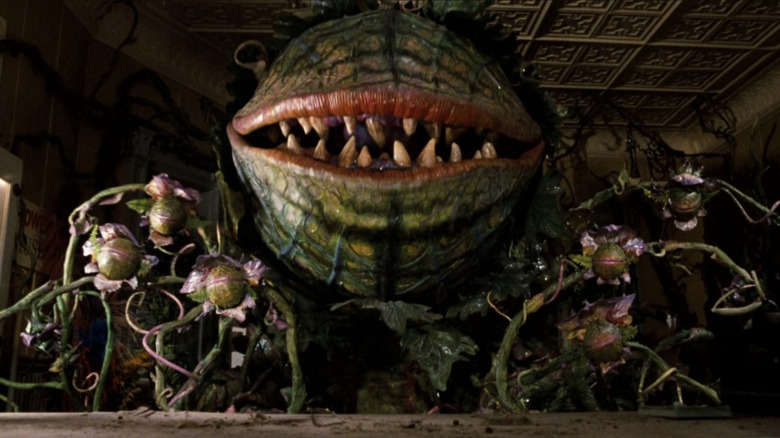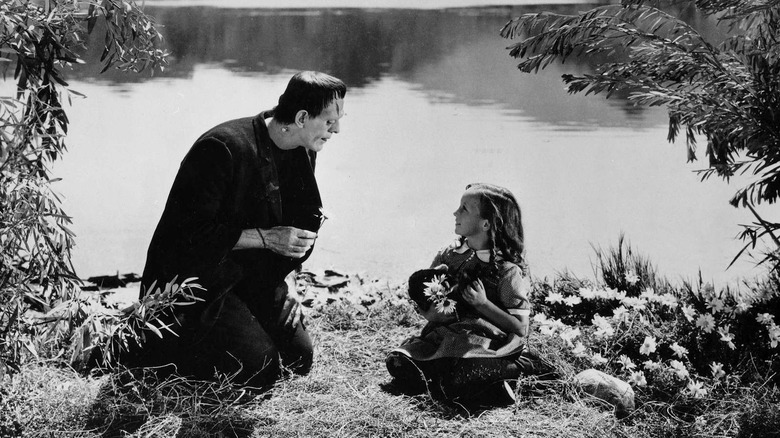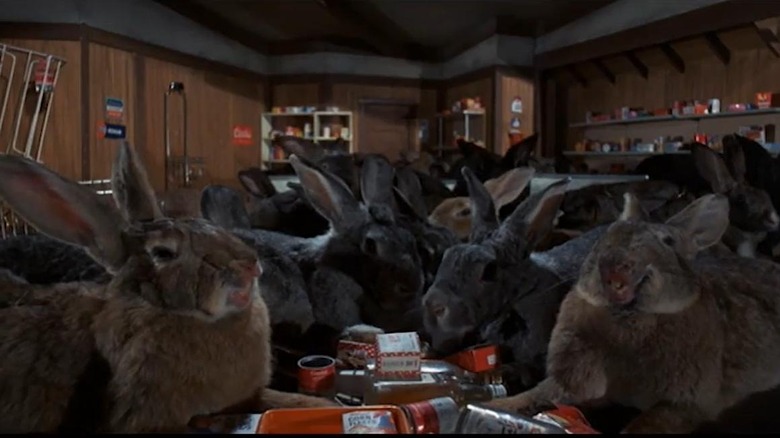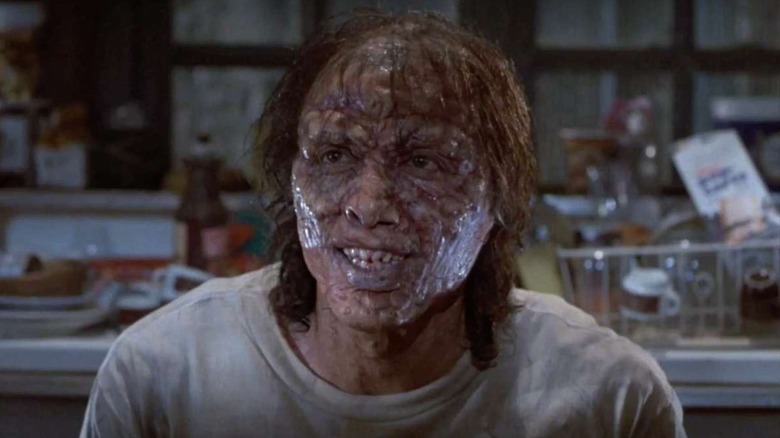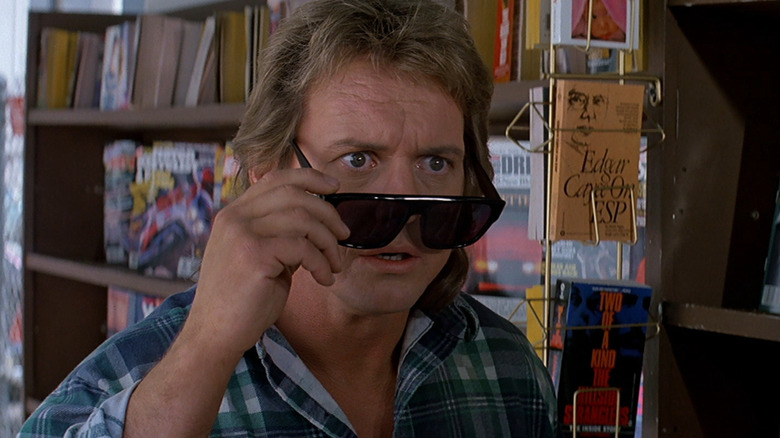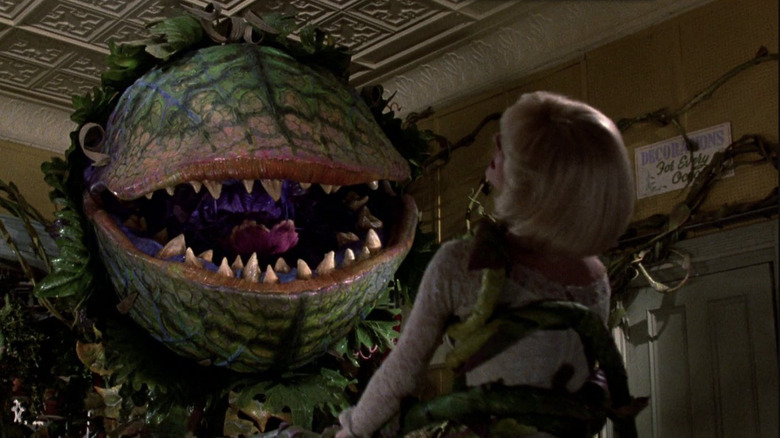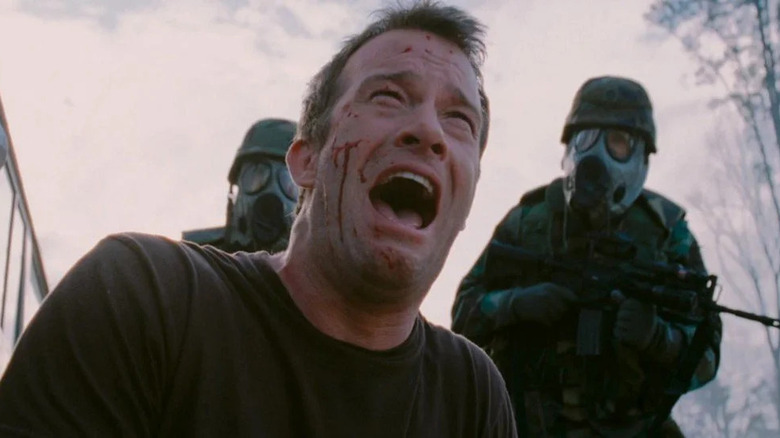Sci-Fi Horror Movies Most People Could Actually Survive
Charles Darwin famously theorized that evolution was the result of "survival of the fittest." When it comes to surviving science-fiction horror movies, brains almost exclusively rule over brawn. Science-fiction horror deals with stories that feel beyond the capabilities of our wildest imaginations, but the horrors are often defeated by using the ol' noggin and executing critical thinking skills learned in even the most rudimentary science classes. Sure, there are movies like "Alien" that could be survived by simply "not being an astronaut and staying at home with Jones the cat," or refusing to get the brain operation in "Possessor," but what about the films that throw humanity into the thick of it?
Fortunately, by trusting your natural instincts, exercising empathy, and using common sense, there are plenty of sci-fi horror films that the average person could actually survive.
Frankenstein
Mary Shelley invented the science-fiction genre of literature with her 1818 novel "Frankenstein," which was later turned into the 1931 film that helped birth the boom of Universal Monster movies. In a horror tale as old as time, the brilliant (albeit possibly mad) Dr. Frankenstein (Colin Clive) reanimates a creature made of assembled body parts of the deceased. Dr. Frankenstein along with his loyal assistant, Fritz (Dwight Frye), successfully brings the creature (Boris Karloff) to life but all hell breaks loose when the creature escapes the lab, confused and traumatized by his own existence. The locals are immediately terrified of the creature, terrorizing him with fire and pitchforks inside of a windmill.
Of all of the science-fiction horror films to exist, "Frankenstein" would be the easiest for most people to survive. The creature known as Frankenstein's monster isn't actively dangerous, just a very lost and confused creation that needs help. The poor thing doesn't know its own strength or the fact that little girls cannot float in water like a daisy. The average person can recognize that this is a creature in need of assistance, and the hope is that most people would heed the call and react accordingly. Then again, maybe humanity and its current love of mob mentality thinking is getting a little too much credit for this one.
Night of the Lepus
1978's "Night of the Lepus" is an animal attack movie with such a ridiculous premise, it's almost shocking that the film exists at all. Sci-fi horror is filled with nightmarish premises like killer bugs, swarms of birds, and giant, electromagnetic lizards, but "Night of the Lepus" wants audiences to run in terror from ... giant rabbits. Horror icon Janet Leigh ("Psycho") stars in this film based on Russell Braddon's 1964 science-fiction novel, "The Year of the Angry Rabbit," that features an infestation of mutated rabbits.
What makes "Night of the Lepus" easy to survive is also what makes the film such a beloved cult favorite. The production of "Night of the Lepus" wanted to showcase the infestation using practical effects and camera tricks, so they filmed domestic rabbits in scenes with miniature models and also had actors dress up in rabbit costumes. The result is a lot of shots of pet rabbits just hanging out in crowded rooms or running around looking confused. It's a little hard to be afraid or threatened by a monster that's probably named "Mr. Hoppity" or something else that sounds like a 2nd grader was in charge.
It's a bunny. Just pick it up. You'll be fine.
The Fly
David Cronenberg took a sci-fi horror movie from 1958 and turned it into the nightmarish body horror masterpiece known as "The Fly." One of the most prominent examples of a horror remake building upon and improving the source material, "The Fly" is often used as a learning tool to show the dangers of man's hubris.
As grotesque, graphic, and gory as "The Fly" is on screen, the actual events of "The Fly" would be incredibly easy for most people to survive. For starters, the horror of "The Fly" is individualistic as the inciting horrific incident stems completely from the decisions of Dr. Seth Brundle (Jeff Goldblum). "The Fly" isn't a mass plague of mutation or an epidemic, it's the result of one man's poor choice.
There are so many people out there that find "The Fly" to be one of the scariest films they've ever seen, despite the fact they'll never be faced with the possibility of turning into a flyman. For starters, a regular person is not going to be researching teleportation technology, so even being near the lab is next to impossible, but if for some reason an average Joe made it inside, surviving "The Fly" is as easy as not stepping into the telepods. Okay, sure, Brundlefly himself is also something to be concerned with, but fortunately, Geena Davis knows the correct course of action. If anything, we should all be thanking her for keeping us alive.
In any case, use Dr. Brundle's poor choices as a learning moment, and try not to treat yourself as a human test subject.
They Live
If a man comes up to you looking like Rowdy Roddy Piper and tells you to put on a pair of sunglasses to see the truth of the world, you put on the dang glasses!
John Carpenter's sci-fi action horror film "They Live" is a stunning exploration of surveillance culture, government overreach, and the way the media contributes to the control of the masses. In 1988 when the film was released, it may have seemed more likely that people would willingly fall into the trap of believing everything they read in the papers or see on TV, but for a 2022 viewer, there's bound to be a lot more skepticism.
Today's audiences often joke about "the NSA agent living in our phones" and will go to extreme lengths to install virtual private network extensions to keep the government from tracking online activity, which means we're a culture far more willing to believe there's something amiss with the world around us. The average person isn't going to need to fight in an alley for nearly six minutes to finally accept that there's a problem. It is true that there are also a lot of people who think the Earth is flat or that vaccines are dangerous, but fortunately, they're just a very loud minority. The majority of people will have no problem putting on the glasses from "They Live" and seeing things for what they are.
Little Shop of Horrors
The most surefire way to survive "Little Shop of Horrors" unfortunately wound up on the cutting room floor. Frank Oz's masterful movie musical based on the off-Broadway musical (based on the 1960 Roger Corman film) of the same name had to make important edits in order to bring the stage show to the big screen. One of the biggest changes was to the film's ending, which originally featured the song "Finale (Don't Feed The Plants)." Poor Seymour Krelborn had a moral dilemma regarding whether or not he should kill people to keep his magical discovery growing strong, and all could have been avoided had he not allowed himself to be manipulated by a talking plant.
The lyrics to the final song almost serve as instructions on how to stay alive. "Hold your hat and hang on to your soul / Something's coming to eat the world whole. If we fight it we've still got a chance / But whatever they offer you / Though they're slopping the trough for you / Please, whatever they offer you / Don't feed the plants." As long as people listen to the true ending of "Little Shop of Horrors," no one will ever have to worry about turning into plant food.
The Mist
Frank Darabont took Stephen King's novella of "The Mist" and changed the ending in a way that even had King himself feeling shook. Darabont had already adapted plenty of King's work, having helmed "The Shawshank Redemption," "The Green Mile," and his short film "The Woman in the Room," but the ending to "The Mist" continues to rock viewers over 15 years after its release. The film sees a small town covered in a mysterious mist that harbors horrifying monsters ready to consume anyone who dares to go outside. If that wasn't terrifying enough, the unexplainable events inspired humans to make dangerous and unthinkable sacrifices in the hope of survival.
In the film's shocking ending, David Drayton (Thomas Jane), his son, and three other survivors make it to Drayton's car as they drive away in the hopes of finding help. As the car runs out of gas, they all seem to accept their fates, with Drayton providing them all a mercy killing, instead of waiting for the monsters to eat them. Tragically, just a few moments after killing the survivors, the mist begins to clear, revealing the U.S. Army taking down the monsters and restoring society.
When it comes to survival, the average person won't literally jump the gun. Give it a few minutes. There's no need for rash decisions.
